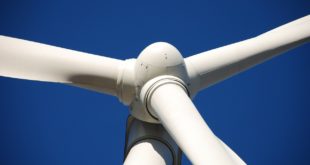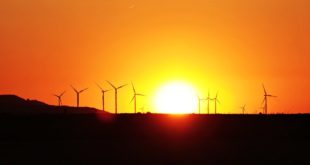What is wind energy? Wind is simply air in motion. Sun’s rays falling on an object heat it up; land heats up faster (and it cools also faster), water heats up slower (and is slower in cooling). Naturally there will be uneven heating of the earth’s surface. During the day, land heats up and the warm air over the land gets lighter and rises up; cooler air from adjoining areas rushes in to take its place, creating breeze or wind.
So what is this about wind energy? In an elementary sense, we can say that an object represents two kinds of energy, potential energy – energy attained by it due to its position – and kinetic energy – energy due to its speed of movement. A body may possess one or both forms of energy. All moving objects represent stored kinetic energy just as an object at a height represents stored potential energy. The wind, a body of air, also represents kinetic energy. It is this wind energy that helps when you sail boats.
How Wind Energy Works
In the old fashioned windmill, wind – the stream of moving air – impinges on the blades of the windmill and causes them to rotate by “pushing” against them; in this process the wind passes part of its kinetic energy to the blades of the windmill and slows down due to loss of part of its energy. The windmill uses the wind energy acquired in this manner in doing the work of pumping water or grinding grains.
Today’s wind mill blades are designed far better so that they are able to extract energy out of the wind (or breeze) blowing over it more efficiently. It is natural that blades of a wind mill designed to produce a large amount of power are large. Windmills with blades measuring about a hundred or two hundred feet across are not uncommon.
Wind Mills And Their Locations
Most of the present day wind mills are the horizontal axis type and they look like huge airplane propellers mounted on a tall tower. The high power machines have blades with very large span and their mounting towers also are very tall; a typical wind machine of this type could be about 250 feet tall with three-bladed propellers about 200 feet across. The turbine shaft is horizontal and quite short. In case of small capacity machines the generator is mounted directly on the turbine shaft; in case of higher capacity machines the turbine shaft drives generator through gears so as to increase the speed of the generator. The electrical cables run down along the tower for delivering power.
Small wind machines for use with single homes or businesses are about 100 kW or less in power; large turbines for commercial use may be with capacities of 5 MW or more. High power installations for delivering wind energy to utility grid or network have a number of wind mills grouped together as wind mill farms.
For efficient operation a wind mill should be situated where the average wind speed is not less than 10 miles per hour. Due to the necessity of the high towers and large sweep of blades necessary, generally wind mills for power applications will not be set up in areas of less than an acre.
Power plants for converting wind energy are generally situated far away from cities. They are set up where wind speed will be high, where obstructions to wind will be less and where seasonal variations will be less. Generally wind speeds are higher at higher altitudes and in open areas. Smooth rounded hills, open plains and shorelines are good sites for wind mills. Mountain gaps are also suitable because they cause wind funneling increasing the speed of wind.
 Alternative Energy HQ solar power for homes, wind energy, and bio fuel issues
Alternative Energy HQ solar power for homes, wind energy, and bio fuel issues








